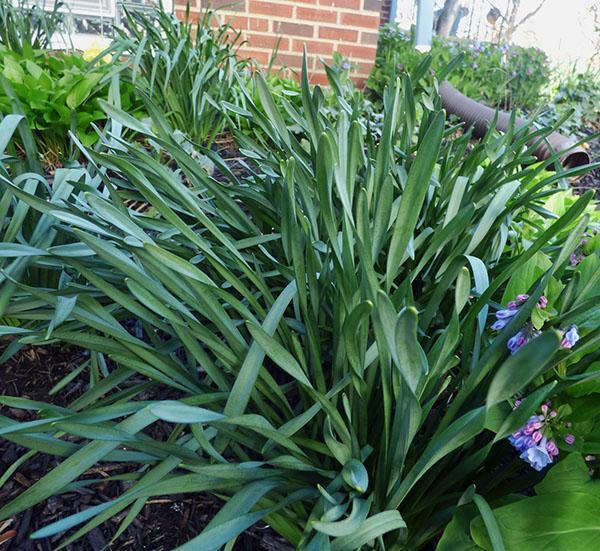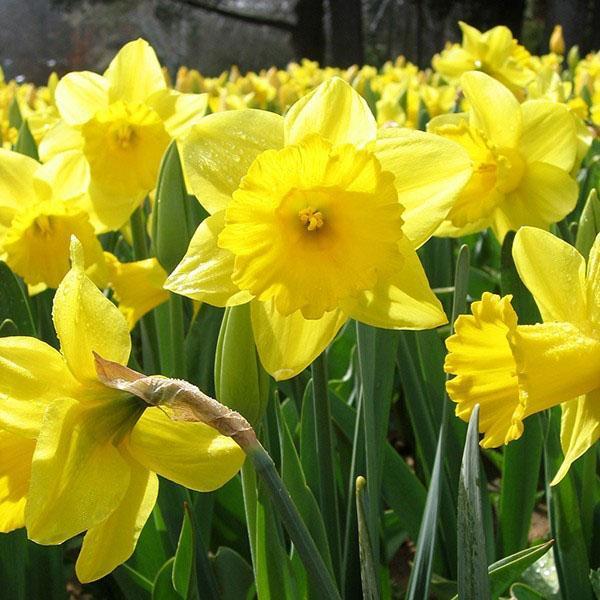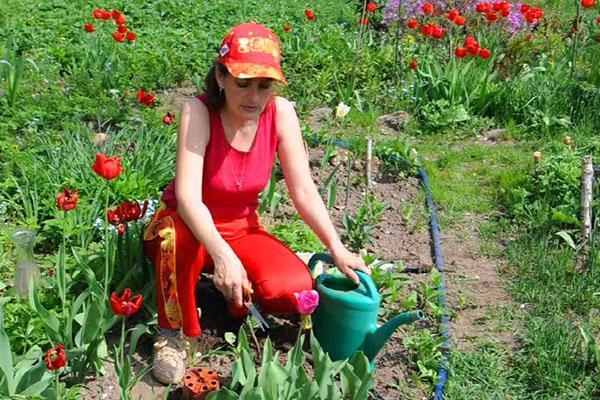How to determine why daffodils are not blooming and achieve their flowering
 Florists often face a problem when growing daffodils. It seems that the care and watering is good, but the plant for some reason does not release color. So, why daffodils don't bloom and what can be done to make the plant throw out the color?
Florists often face a problem when growing daffodils. It seems that the care and watering is good, but the plant for some reason does not release color. So, why daffodils don't bloom and what can be done to make the plant throw out the color?
The main reasons why daffodils do not bloom

Improper watering
 Insufficient watering may be a fundamental factor in why daffodils do not bloom, but only throw out leaves. The roots of daffodils go 30 cm deep, and the dry soil near the root is detrimental to the flower. The plant simply has nowhere to get all the substances necessary for growth and flowering, the roots gradually begin to die off. At first, the daffodil stops producing inflorescences, and soon the entire perennial dies.
Insufficient watering may be a fundamental factor in why daffodils do not bloom, but only throw out leaves. The roots of daffodils go 30 cm deep, and the dry soil near the root is detrimental to the flower. The plant simply has nowhere to get all the substances necessary for growth and flowering, the roots gradually begin to die off. At first, the daffodil stops producing inflorescences, and soon the entire perennial dies.
Do not stop watering the daffodils after flowering. Moisture feeds the bulb, which will help the plant grow abundantly next season.
And also the reason why daffodils do not bloom can be an excess of moisture. In case of excessive watering, the roots of the plant are completely in the water and begin to rot. The flower begins to ache, and naturally, there can be no question of any flowering.
Close fit
 Another reason why daffodils do not bloom is the close planting of inflorescences. The fact is that the daffodil is a perennial plant and has a branched root system. And very closely spaced plants for several years are able to braid the neighboring bulb quite strongly. As a result, the inflorescence begins to receive less oxygen, moisture and essential nutrients. Perhaps he will have the resources to form leaves, but for flowering, he may not have enough strength.
Another reason why daffodils do not bloom is the close planting of inflorescences. The fact is that the daffodil is a perennial plant and has a branched root system. And very closely spaced plants for several years are able to braid the neighboring bulb quite strongly. As a result, the inflorescence begins to receive less oxygen, moisture and essential nutrients. Perhaps he will have the resources to form leaves, but for flowering, he may not have enough strength.
Experienced growers advise replanting the plant at least once every 3 years. And some gardeners, in order to achieve lush flowering, practice transplanting daffodils every year.
The flower is transplanted when the leaves are withered and completely lay down. This happens around the beginning or mid-August.
Unsuitable soil
 Another reason why daffodils do not bloom in the garden is too acidic soil. For growing daffodils, the most optimal is a slightly acidic soil, fluctuating within 5-7 pH units.
Another reason why daffodils do not bloom in the garden is too acidic soil. For growing daffodils, the most optimal is a slightly acidic soil, fluctuating within 5-7 pH units.
If the lack of flowering lies precisely in this, the situation can be corrected by adding the following elements to the substrate:
- a piece of chalk;
- lime flour;
- dolomite flour.
It is recommended to add such additives to the soil several months before the direct planting of plants.
Malnutrition
 Many growers cannot get daffodils flowering, even providing them with adequate watering and an annual transplant. So why don't daffodils bloom with proper care, and what can you do to get the plant to bloom?
Many growers cannot get daffodils flowering, even providing them with adequate watering and an annual transplant. So why don't daffodils bloom with proper care, and what can you do to get the plant to bloom?
 In order for daffodils to bloom profusely, it is worth remembering a few rules:
In order for daffodils to bloom profusely, it is worth remembering a few rules:
- It is necessary to carry out annual fertilizing of the soil with nitrogen substances. But I must say that the excess nitrogen in soil may cause lack of flowering. In order not to overfeed the soil, fertilize the substrate with mixtures containing these or those trace elements in equal proportions.
- The plant should be planted in full sun. A culture that grows in the shade may not bud.It is also better to plant daffodils separately from tall plants, so as not to create shadows.
Damage to the bulb
 Daffodils may not bud due to an injured or damaged bulb.
Daffodils may not bud due to an injured or damaged bulb.
The flower bulb can be damaged by:
- low temperatures;
- pests;
- unsuitable substrate;
- disease.
Therefore, it is extremely important to treat the plant on time, get rid of pests, and remove damaged bulbs. And also in order to avoid freezing of the bulb, the soil where the perennial grows for the winter is recommended to be insulated: peat, dry leaves, wood chips, sawdust.
To make the narcissus bulb more resistant to various kinds of diseases, immediately before planting it must be soaked in a solution of potassium permanganate.
Untimely cutting of leaves
 And you also need to know that the reason for the lack of flowering in a perennial can be the early cutting of leaves. It is necessary to cut the leaves of a daffodil when the flowers have already completely withered, so as not to disrupt the natural process of photosynthesis.
And you also need to know that the reason for the lack of flowering in a perennial can be the early cutting of leaves. It is necessary to cut the leaves of a daffodil when the flowers have already completely withered, so as not to disrupt the natural process of photosynthesis.
As you can see, there are many reasons why daffodils do not bloom. And even a novice florist can identify any of them without difficulty.